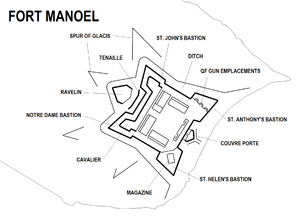Fort Manoel
| Fort Manoel | |
|---|---|
| Forti Manoel | |
| Manoel Island, Gżira, Malta | |

View of Fort Manoel from the sea
|
|

Map of Fort Manoel
|
|
| Coordinates | 35°54′10″N 14°30′19″E / 35.90278°N 14.50528°E |
| Type | Star fort |
| Site information | |
| Owner | Government of Malta |
| Controlled by | MIDI plc |
| Open to the public |
Yes |
| Condition | Intact |
| Site history | |
| Built | 1723–1733 |
| Built by | Order of Saint John |
| In use | c. 1734–1964 |
| Materials | Limestone |
| Battles/wars |
Capture of Malta (1798) Siege of Malta (1798–1800) World War II |
Fort Manoel (Maltese: Forti Manoel or Fortizza Manoel) is a star fort on Manoel Island in Gżira, Malta. It was built in the 18th century by the Order of Saint John, during the reign of Grand Master António Manoel de Vilhena, after whom it is named. The British military took over the fort in 1800 and it remained in use by them until 1964. The fort was severely damaged in World War II, but it was restored and it is now in good condition.
Fort Manoel is located to the north west of Valletta, and commands Marsamxett Harbour and the anchorage of Sliema Creek. The fort is an example of Baroque architecture, and it was designed with both functionality and aesthetics in mind.
Fort Manoel has been on Malta's tentative list of UNESCO World Heritage Sites since 1998, as part of the Knights' Fortifications around the Harbours of Malta.
In the 16th century, the Marsamxett Harbour was one of the two major harbours in the Maltese city of Valletta. In the centre of the harbour was an island, originally known as l'Isolotto and now known as Manoel Island after the fort, which overlooked the city. Shortly after Valletta's construction, the Order of Saint John realised this was a potential vulnerability in the city's defences. As early as 1569, it was proposed that a small fort with a cavalier be built on the Isolotto to prevent the enemy from taking the island and building batteries on it. The threat was again highlighted by the Spanish military engineer Scipione Campi in 1577, and by Giovanni Battista in 1582.
...
Wikipedia
